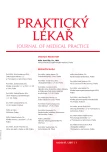Risk factors of falls in hospitalized patients
Authors:
I. Bóriková; M. Tomagová; K. Žiaková
Authors‘ workplace:
Vedúca: prof. Mgr. Katarína Žiaková, PhD.
; Jesseniova lekárska fakulta v Martine
; Ústav ošetrovateľstva
; Univerzita Komenského v Bratislave
Published in:
Prakt. Lék. 2017; 97(1): 26-30
Category:
Of different specialties
Overview
Aim:
To identify risk factors of falls in hospitalized patients and to identify which ones are associated with high risk of fall.
Methods:
The pilot cross-sectional study was performed in sample inpatients on internal and surgical departments. The risk of fall was assessed by identifying of risk factors for falls and by Morse Fall Scale (MFS). This tool assesses six key risk factors for fall and cut-off score ≥ 45 (the range of 0 to 125) and identifies patients with high risk for fall, which initiates the selection of targeted preventive interventions to for reducing the risk of fall.
Results:
In sample of 63 patients with a mean age of 68.3 years was the mean score of fall risk by MFS at high risk 60.6 ± 22.4. Up to 47 patients (74.6%) had a high risk of fall (MFS score ≥ 45). The highest risk of fall had patients oldest age sample (> 74 years). The most common risk factors for the falls in whole sample belonged abnormal of gait and balance (n = 53), acute diagnosis (n = 46), secondary diagnosis (n = 40), using of an ambulatory aid (n = 37) and polypharmacotherapy (n = 37). In sample of patients at high risk of fall were statistically significant correlations between the fall history (p = 0.000), abnormal gait and balance (p = 0.000), using of an ambulatory aids (p = 0.010) and polypharmacotherapy (p = 0.030) related to high risk of fall.
Conclusion:
Screening for risk of falls should be implemented always during patient receiving and a significant change in his health condition with aim to identify risks factors increasing the risk of falls. Result of this assessment is the basal for the selection and implementation of targeted multifactorial interventions. Valid and reliable tool MFS is able to detect a significant risk of fall, but after detection of fall risk, patient should be comprehensively examined with a focus on specific identified risk factors. MFS is necessary further tested in various areas of clinical practice with aim to prepare the standardized methodology for identifying patients with risk of fall.
Keywords:
fall – risk factors – inpatients – assessment – Morse Fall Scale
Sources
1. Callis N. Falls prevention: Identification of predictive fall risk factors. Appl Nurs Res 2016; 29: 53–58.
2. Centre for Clinical Practice at NICE (UK). Falls Assessment and prevention of falls in older people. NICE Clinical Guideline 161. London: National Institute for Health and Care Excellence 2013.
3. Dias M, Oliveira SA, Martins T, et al. Medication fall risk in old hospitalized patients: A retrospective study. Nurse Educ Today 2014; 34: 171–176.
4. Európska komisia, Pracovná skupina pre bezpečnosť pacienta a kvalitu starostlivosti. Kľúčové zistenia a odporúčania týkajúce sa systémov podávania správ o incidentoch súvisiacich s bezpečnosťou pacienta a poúčania sa z týchto incidentov v Európe [online]. Dostupné z: http://ec.europa.eu/health//sites/health/files/patient_safety/docs/guidelines_psqcwg_reporting_learningsystems_sk.pdf [cit. 15-1-2017].
5. Gu YY, Balcaen K, Ni Y, et al. Review on prevention of falls in hospital settings. Chinese Nursing Research 2016; (3): 7–10.
6. Chang VC, Do MT. Risk factors for falls among seniors: implications of gender. Am J Epidemiol 2015; 181(7): 521–531.
7. Chung H, Coralic A. A multidisciplinary assessment instrument to predict fall risk in hospitalized patients: A prospective matched pair case study. J Nurs Educ Pract 2016; 6(6): 1–7.
8. Jarošová D, Majkusová K, Zeleníková R, a kol. Prevence pádů a zranění způsobených pády u starších dospělých [online]. Adaptovaný klinický doporučený postup Prevention of falls and fall injuries in the older adult (2005), Supplement (2011). RNAO. Ústav ošetřovatelství a porodní asistence, Lékařská fakulta, Ostravská univerzita 2014. Dostupné z: http://dokumenty.osu.cz/lf/uom/uom-publikace/kdp-pady-plna-verze.pdf [cit. 20-12-2016].
9. Joint Commission. Preventing falls and fall-related injuries in health care facilities. Sentinel Event Alert 2015; (55): 1–5.
10. Majkusová K, Jarošová D. Falls risk factors in an acute-care setting: a retrospective study. Cent Eur J Nurs Midw 2014; 5(2): 47–53.
11. Marshall FJ. Approach to the elderly patient with gait disturbance. Neurol Clin Pract 2012; 2(2): 103–111.
12. Mion LC, Chandler AM, Waters TM, et al. Is it possible to identify risks for injurious falls in hospitalized patients? Jt Comm J Qual Patient Saf 2012; 38(9): 408–413.
13. Morse JM. Preventing Patient Falls. Establishing a Fall Intervention Program. 2nd ed. New York: Springer Publishing Company 2009.
14. Suttanon P, Hill KD, Said CM, Dodd KJ. A longitudinal study of change in falls risk and balance and mobility in healthy older people and people with Alzheimer disease. Am J Phys Med Rehabil 2013; 92(8): 676–685.
15. Titler MG, Conlon P, Reynolds MA, et al. The effect of a translating research into practice intervention to promote use of evidence-based fall prevention interventions in hospitalized adults: A prospective prepost implementation study in the U.S. Appl Nurs Res 2016; 31: 52–59.
16. Watson BJ, Salmoni AW, Zecevic AA. The use of the Morse Fall Scale in an acute care hospital. Clin Nurs Stud 2016; 4(2): 32–40.
17. Weber P, Meluzínová H, Prudius D, Bielaková K. Polyfarmakoterapie nahlížená nejen prizmatem multimorbidity, ale jako další geriatrický syndrom. Vnitř Lék 2016; 62(Suppl 3): 135–139.
18. WHO. WHO Global Report on Falls Prevention in Older Age. Ženeva: WHO 2007.
19. Zeleníková R, Kozáková R, Jarošová D. Intervence v prevenci pádů seniorů v institucích: přehledová studie. Prakt. Lék. 2015; 95(1): 20–30.
Labels
General practitioner for children and adolescents General practitioner for adultsArticle was published in
General Practitioner

2017 Issue 1
Most read in this issue
- Paracetamol poisoning
- Risk factors of falls in hospitalized patients
- Multiple chemical sensitivity
- Duties of attending physician in assessing the health status for the purposes of disability, social security benefits and employment
